You are using an out of date browser. It may not display this or other websites correctly.
You should upgrade or use an alternative browser.
You should upgrade or use an alternative browser.
"What Madness Is This?" - A Timeline
- Thread starter Napoleon53
- Start date
The slavic countries should annex the RU and slavicise them
Turn them into everything they ever hated
Well, Russia is aiming for world domination now.
Yep now they are nazis it could only be worse if they start the holocaust
Still it surprise me than even in another TL Stalin is a dictator only that now is Stalin+Hitler in the Nazi US
OMG this is bad
They basically already have started the Holocaust, I'm just trying to make it not exactly like OTL Nazis. It's more of a Soviet gulag feel, with lots of vicious guards, instead of organized gas chambers.
George Washington was sterile.
And I have to say that I am disappointed in the amount of information for the future given in the post on who would win.
I pointed this out a long time ago (months), so in case anyone else forgot, George Washington is not sterile in this (his whole life is slightly different), and he has descendents like anyone else. The Washingtons have been mingled into this TL for a long time, part of their plot to redeem George Washington I's legacy of failure and restore honor to the family name. George Washington VIII is a Patton/MacArthur combo, character wise.
I posted about who would win?!
Welp at least there aren't DEATH CAMPS but there are still Concentration Camps, so can I write the South American Front or there sin't to be any fighting thereWell, Russia is aiming for world domination now.
They basically already have started the Holocaust, I'm just trying to make it not exactly like OTL Nazis. It's more of a Soviet gulag feel, with lots of vicious guards, instead of organized gas chambers.
I pointed this out a long time ago (months), so in case anyone else forgot, George Washington is not sterile in this (his whole life is slightly different), and he has descendents like anyone else. The Washingtons have been mingled into this TL for a long time, part of their plot to redeem George Washington I's legacy of failure and restore honor to the family name. George Washington VIII is a Patton/MacArthur combo, character wise.
I posted about who would win?!I definitely didn't mean to; I don't even know for sure who will win this current war. I'm still mapping it out.
Here's the second and final Middle East Chapter.  Napo just gave me permission to write two more guest chapters on India and Japan, so expect those soon. Also, the flags of Assyria and Syria were made by me. With the Assyrian flag all I did was remove the top emblem to make it look simpler.
Napo just gave me permission to write two more guest chapters on India and Japan, so expect those soon. Also, the flags of Assyria and Syria were made by me. With the Assyrian flag all I did was remove the top emblem to make it look simpler.
The Egyptian Empire was by far the greatest power in the Middle East by the mid-20th century. In a relatively short time the former Ottoman puppet state had grown to become a major industrial, economic and military power in the region, and by the end of the century, it would grow to become a power on the world stage. Egypt's first years of independence were quiet, and were a time of consolidation for the newly independent nation. Then in 1895, Egypt's first Sultan-Emperor Isma'il I died, leaving his twenty-one year old son Abbas as Sultan-Emperor Abbas I of Egypt and Sudan. When this happened, many in the Egyptian government, Royal Council, and military were highly worried and saw a crisis on the horizon. However, Abbas I was an intelligent young man, and almost immediately he surrounded himself with highly competent advisers from the Royal Council.
In addition, Abbas I knew that Egypt was but a young backwater, and therefore sought to strengthen his nation militarily, politically, and economically. Firstly, a number of reforms in the military were passed during the late 1890s and 1900s, and with the help of new weapons, such as the Eiffel Arms 1893 Bolt-Action Rifle bought from the Tripartite Empire, the Egyptian Military grew to become the strongest army in the Middle East by 1910.
It was also during this era that (as a result of buying weapons from the Tripartite Empire) Egypt became closer with the Empire, and the Empire would become Egypt's main Western ally in the years to come. The reasons for this friendship were that the two nations had many similar goals in the Middle East, the Empire wanted more rights from ports in the Suez, which in turn brought trade to Egypt, and that the Empire's support of Egypt helped maintain a balance of power in the region. Starting in 1898, Egypt under Abbas I underwent a major series of reforms in the government, civil service, city infrastructure and public works, all reforms which were completed by the 1920s. Also, during the 1900s and through to the 1930s and beyond, Egypt looked increasingly to the West for modernization due to all the reforms already going through, those in the military inspired in part by the Empire's military, as well as to a lesser degree, the militaries from a number of other European nations. While the more conservative elements prevented a number of modernization reforms, most of the reforms were still pushed through anyway, due to backing from Abbas I himself, who had most of the authority over the Egyptian Assembly in the first place.
Another one of the biggest developments in Egyptian history during this period was the construction of the Suez Canal. For years, the Western Powers, particularly the Tripartite Empire, had desired to build a canal in the Suez to better connect their far-flung colonial holdings. However France-Spain (later the Tripartite Empire) was too focused on other events in Europe, Africa and Asia to conquer the Suez from Egypt and build the canal. Other major powers just didn't have the influence and power in the region to do so, either. Then, beginning in the late 1910s, Sultan Abbas I saw the creation of a canal as a major business opportunity and a way to increase trade, commerce, and relationships with the west. Abbas I went into an agreement with the Empire's government and the newly established Imperial Canal Company in the 1920s, and construction on the Suez Canal began on October 15, 1922. It was finally completed on December 29, 1931, greatly improving traffic to and from the European nations and their respective colonies, and it also made the Egyptian Empire an increasingly wealthy nation and a crossroads between the Western and Eastern worlds. After all these developments, by the 1930's, Egypt was a fully industrial and modern regional power on the same level as other Western/European Powers.
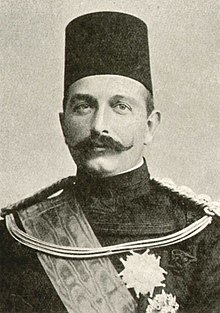
Sultan-Emperor Abbas I
The next major challenge for Egypt came in the late-1920s through to the mid-1930s, when Arab, Maronite, Assyrian, and Jewish refuges flooded into northern Egypt and Sudan from the Turkish Levant. While Conservative elements in the country called for their expulsion and a few pogroms broke out in some major cities, Egypt was now a modern and nominally progressive power, and in recent decades relations between Muslims and Christians (for example, Coptics) in Egypt noticeably improved. Abbas I had come to side with the more progressive and reform minded elements in the country, and in the past years had openly ordered the protection of Egyptian Christians and other "Peoples of the Book". While liberal social reforms in Egypt would be implemented for years to come, this was a good start. Abbas I openly supported protection and housing for the refugees, and in a speech made in Cairo in 1933 stated his agenda "to free the peoples of the book from Turkish tyranny and a false Caliphate". Terzi Pasha was furious, and after these events, tensions between the Egyptian Empire and the Islamic Republic of Turkey only escalated, with a military buildup going on in both nations during the 1930s. Finally in October of 1938 a series of border skirmishes began on the Eygpto-Turkish border between the two nation's armies. The skirmishes went on and off for months, with Egypt officially declaring war on Turkey on May 12, 1939. Egypt already had a superior army, with recent landships and aeroships being bought from the Empire, but the Turkish Army, using Prussian bought weapons, put up a good fight at first. A stalemate at an ever-changing battle line outside of Jerusalem lasted for almost two years, until Egypt finally broke through in November of 1940. Months later, from February 4-9, 1941, the Egyptian Army marched into Jerusalem and forced the Turkish army to retreat after the grueling-but-climactic Battle of Jerusalem (the event became an inspiration for pop culture the world over, with French director Marcel Laval's 1946 film Terre Sainte and Virginian director Hubert Stockton's 1952 film Jerusalem both becoming instant film classics). It was also during the stalemate and famous battle that many foreign troops rallied to the Egyptian cause. "Catholic Brigades" from Europe and the Americas and Russian-led "Orthodox Legions" became the most famous, as well as the International Jewish Bridges (IJB) made up of Jews from Europe, the Americas, and Middle East. Those Jews rallied behind Egypt's increasingly friendly relationship to Jewry to fight for the liberation of the Holy Land, some hoping for an eventual creation of a Jewish state. These brigades captured the world's imagination, with a number of films, novels and comic books based on their exploits being made worldwide during the 1940s and 1950s.
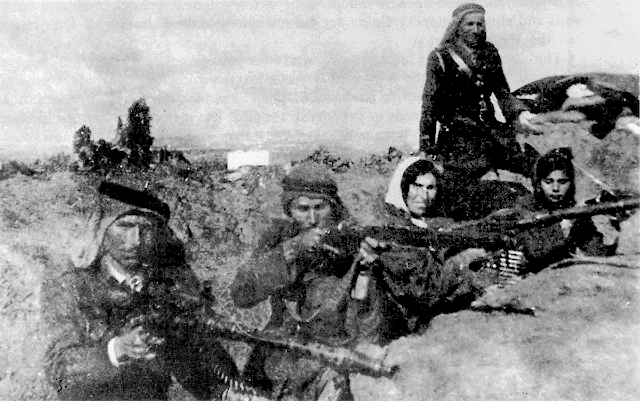
Egyptian Volunteer Infantry in a trench outside of Jerusalem, February 4, 1941
After the Battle of Jerusalem, Egypt now had the upper hand in the war. Through mid-1941 to early-1943, the Egyptian Army gradually conquered city after city in the Levant, with the help of a number of local revolts by minority groups against Turkish rule, some directly supported by Egypt. By mid-1943, the Turkish Army, weakened by the constant loses, had completely lost control of the Levant to either the Egyptian Army or to the variety of different rebel groups. Then on July 1, 1943, came another climactic battle: the Battle of Antioch. The battle itself, between the Egyptian and Turkish Armies, the later led personally by Grand Leader Terzi Pasha, himself a former Army officer, was a brutal and bloody stalemate. However, the battle was significant for the death of Terzi Pasha, who was shot off of his stallion by an Egyptian sniper.
After Antioch, the Turkish government was in near chaos, with Army General Barış Bardakçı coming to power thought a violent coup just a week after the battle. Bardakçı refused to surrender to the Egyptians at first but finally did so on October 30, 1943, seeing no other way out of the war. The Treaty of Damascus, signed on January 1, 1944, officially ended the conflict. The Treaty forced Turkey to cede it's land in the Levant to Egypt as an occupied territory, and for Grand Leader Bardakçı to renounce his title of Caliph of Islam. The Egypto-Turkish war humiliated the IRT, but was a great triumph for the Egyptian Empire, and showed that it was truly a force to be reckoned with. The war also showed the power of new military tactics and technology, and was in many ways a preview for the coming World War.
Abbas I was hailed as a hero back in Cairo, and he was hailed as the "Father of the Modern Egyptian Empire". Abbas I finally died on December 19, 1944 and was succeed by his son, Prince Isma'il Abdel Moneim, who became Sultan-Emperor Isma'il II (*). It was under Isma'il II's reign, in 1948, that the Occupied Levant was restructured. Two new nations were established; the Assyrian Republic, a nation for the Assyrian people, which was militarily neutral but under Egyptian protection, and the Kingdom of Syria, a state created due to the fact that Egypt did not want to risk annexing a large amount of Christian land, and also to create a nation in which both Muslims and Christians, be they Maronite or Orthodox, could co-exist without sectarian violence. The Kingdom of Syria was made an Egyptian puppet state, with Prince Ghazi bin Faisal of the progressive Arabian Hashemite Dynasty being made the nations first King and Ghazi I of Syria (*). The rest of the Levant, the majority Arab and Muslim Palestine, was annexed to the Egyptian Empire.
(* IOTL Isma'l II was named Prince Mohammed Abdel Moneim. His given name is different IITL due to butterflies)
(*IOTL King Ghazi I was the second King of Iraq. Also ITTL, he does not die in 1939 as IOTL, and lives a much longer life)

Sultan-Emperor Isma'il II

Flag of the Assyrian Republic

Flag of the Kingdom of Syria

King Ghazi I of Syria
It was also during Isma'il II's reign that Pan-Arabism grew increasingly popular in Egypt, due to the new Arab land won in the Egypto-Turkish War, and how Egypt was seen as standing up for Arab's living in tyranny under non-Arab rule. A number of successful new Pan-Arabist parties were established during his reign, and in 1951, Isma'il II publicly came out as a Pan-Arabist, giving more strength to the movement. That same year Egypt began to foster a closer relationship with the Arab Republic of Iraq, a relationship which would prove to have vital repercussions in the future. Isma'il II was also one of the many world leaders to attend Napoleon V's Funeral in Paris in 1950. Sadly, his reign would not last for many years longer. On October 16, 1953, Isma'il II was assassinated in Alexandria by Harun Hakim, a crazed Egyptian Anarcho-Socialist.
Ismai'l II's thirty-one year old son succeed him as Sultan-Emperor, and became Sultan-Emperor Isma'il III (*). A crackdown on Anarchists in the country ensued afterwards. Aside from this, Isma'il III was a staunch Pan-Arabist, and continued backing the Pan-Arabist policies his father had begun, with the Arab Republic of Iraq becoming an Egyptian client state. Then in 1955, the World War broke out. Isma'il III kept his country neutral, though favorable towards the League of Nations. However later that year and into 1956, the Russian Republic invaded Persia and was poised to invade more of the Middle East. As a result, Egypt under Isma'il III signed an alliance with Russia. This alliance would later serve to strengthen Pan-Arabism by giving Russia and Egypt their own sphere's of influence in the Middle East, Russia a non-Arab sphere and Egypt an Arab sphere. Things came even more to a head when in 1958, Isma'il III declared himself Caliph of Islam with the support of a number of Islamic Clerics from around the Middle East. In later years, when the Kingdom of Arabia showed signs of further weakness, the idea of a "United Arab Empire" became more and more plausible.
(*Isma'l III is a fictional character, and is not based on any OTL Egyptian pretender in particular)

Flag of the Kingdom of Rashidi Arabia
During most of the early to mid-twentieth century, the Arabian peninsula was a war torn, dangerous and all around troubled region of the world. In the late 1890's and early 1900's, one rising and potential power in Arabia was the Emirate of Jabal Shammar. While originally an ally of the Ottoman Empire, under the reign of Muhammed I bin Abdullah and after the Tripolitanian War, the kingdom gradually turned more to Western Powers, especially the Tripartite Empire and Russia. By 1900, Jabal Shammar had a more or less modernized army, made up mostly of Infantry, and at the Treaty of Antioch ending the Russo-Turkish War, Jabal Shammar was, under approval from Western Powers, given the Hejaz region formally owned by the recently defunct Ottoman Empire. However this territorial concession would lead to many more problems in the long run. The main rival to Rashidi Arabia was the Second Saudi State in the region of Nejd in southern Arabia, a strictly conservative Islamic state ruled by the house of Saud in southern Arabia. However they were a troubled and weak backwater due to constant infighting in the Saudi family, and the state was finally conquered by Rashidi Arabia in 1907, by this point ruled by Amir Abdul-Aziz bin Mitab. However the many members of the House of Saud fled to the countryside, and in the coming years started an insurgency against the Rashidi invaders, an insurgency supported by Ultra-Conservative Islamic clerics and leaders who disapproved of the Rashidi's more moderate view of the Islamic faith.
Another insurgency against the Rashidi's was lead by the House of Hashim around Hejaz and Mecca, despite being allowed to have autonomy over Mecca after the Rashidi annexation. The two insurgencies lasted in Rashidi Arabia for decades, and raids, bushwackings and violent surprise attacks were all too common a sight in the barren Arabian deserts and cities alike. This made obtaining oil form Arabia, whether by the Rashidi government or by Western Powers, a dangerous and rarely executed venture. As a result, most of the world's oil had to be bought from no where else but the Republican Union, a fact many European Powers resented. Only in the early 1940's, when the Saudi and Hashemite insurgencies finally burned out, did it become safe to obtain oil from Arabia, but by this point it was too late and the R.U. had profited immensely from the previous and long-lasting turmoil in Arabia. Then, in the late 1950s, signs of instability showed once again, as pro-Saudi and pro-Hashemite militias were established by veterans of the old insurgencies. Not only that, but Beutelist, Distributive Socialist, Anarcho-Socialist, and even Islamo-Socialist rebel groups began to form in the Arabian cities and villages, these ideas themselves coming from years of increasing trade by the Rashidis with the West. A number of Ultra-Conservative Islamic and Pan-Arabist rebel groups formed as well, and Rashidi Arabia seemed poised for another civil war, a war destined to be more brutal then the last. A number of small scale, but violent rebellions soon broke out, and one local power saw an opportunity to invade the country and bring it order to the region once and for all; that power being the Egyptian Empire...
Other states in the Arabian Peninsula, such as Kuwait, the Trucial States, Oman, Yemen, Qatar, and Bahrain, were but quiet backwaters. None of these states ever fell to Western Imperialism, with the possible exception of Oman, which lost a number of Islands and its possessions in Persia to Prussia during the four month long Prusso-Omani War of 1899 (a war waged by Prussia in an effort to increase its power in the Indian Ocean), although it was never conquered by Prussia and remained independent. The ideology of Pan-Arabism spread to some of these states, such as to Yemen and Kuwait in the 1940s, while it simply never caught on in the rest, such is in Oman, which was an Ibadi Islamic state and had no desire to unite with its Sunni neighbors.
THE MIDDLE EAST
Part Two
Egyptian Empire

Part Two
Egyptian Empire

The Egyptian Empire was by far the greatest power in the Middle East by the mid-20th century. In a relatively short time the former Ottoman puppet state had grown to become a major industrial, economic and military power in the region, and by the end of the century, it would grow to become a power on the world stage. Egypt's first years of independence were quiet, and were a time of consolidation for the newly independent nation. Then in 1895, Egypt's first Sultan-Emperor Isma'il I died, leaving his twenty-one year old son Abbas as Sultan-Emperor Abbas I of Egypt and Sudan. When this happened, many in the Egyptian government, Royal Council, and military were highly worried and saw a crisis on the horizon. However, Abbas I was an intelligent young man, and almost immediately he surrounded himself with highly competent advisers from the Royal Council.
In addition, Abbas I knew that Egypt was but a young backwater, and therefore sought to strengthen his nation militarily, politically, and economically. Firstly, a number of reforms in the military were passed during the late 1890s and 1900s, and with the help of new weapons, such as the Eiffel Arms 1893 Bolt-Action Rifle bought from the Tripartite Empire, the Egyptian Military grew to become the strongest army in the Middle East by 1910.
It was also during this era that (as a result of buying weapons from the Tripartite Empire) Egypt became closer with the Empire, and the Empire would become Egypt's main Western ally in the years to come. The reasons for this friendship were that the two nations had many similar goals in the Middle East, the Empire wanted more rights from ports in the Suez, which in turn brought trade to Egypt, and that the Empire's support of Egypt helped maintain a balance of power in the region. Starting in 1898, Egypt under Abbas I underwent a major series of reforms in the government, civil service, city infrastructure and public works, all reforms which were completed by the 1920s. Also, during the 1900s and through to the 1930s and beyond, Egypt looked increasingly to the West for modernization due to all the reforms already going through, those in the military inspired in part by the Empire's military, as well as to a lesser degree, the militaries from a number of other European nations. While the more conservative elements prevented a number of modernization reforms, most of the reforms were still pushed through anyway, due to backing from Abbas I himself, who had most of the authority over the Egyptian Assembly in the first place.
Another one of the biggest developments in Egyptian history during this period was the construction of the Suez Canal. For years, the Western Powers, particularly the Tripartite Empire, had desired to build a canal in the Suez to better connect their far-flung colonial holdings. However France-Spain (later the Tripartite Empire) was too focused on other events in Europe, Africa and Asia to conquer the Suez from Egypt and build the canal. Other major powers just didn't have the influence and power in the region to do so, either. Then, beginning in the late 1910s, Sultan Abbas I saw the creation of a canal as a major business opportunity and a way to increase trade, commerce, and relationships with the west. Abbas I went into an agreement with the Empire's government and the newly established Imperial Canal Company in the 1920s, and construction on the Suez Canal began on October 15, 1922. It was finally completed on December 29, 1931, greatly improving traffic to and from the European nations and their respective colonies, and it also made the Egyptian Empire an increasingly wealthy nation and a crossroads between the Western and Eastern worlds. After all these developments, by the 1930's, Egypt was a fully industrial and modern regional power on the same level as other Western/European Powers.

Sultan-Emperor Abbas I
The next major challenge for Egypt came in the late-1920s through to the mid-1930s, when Arab, Maronite, Assyrian, and Jewish refuges flooded into northern Egypt and Sudan from the Turkish Levant. While Conservative elements in the country called for their expulsion and a few pogroms broke out in some major cities, Egypt was now a modern and nominally progressive power, and in recent decades relations between Muslims and Christians (for example, Coptics) in Egypt noticeably improved. Abbas I had come to side with the more progressive and reform minded elements in the country, and in the past years had openly ordered the protection of Egyptian Christians and other "Peoples of the Book". While liberal social reforms in Egypt would be implemented for years to come, this was a good start. Abbas I openly supported protection and housing for the refugees, and in a speech made in Cairo in 1933 stated his agenda "to free the peoples of the book from Turkish tyranny and a false Caliphate". Terzi Pasha was furious, and after these events, tensions between the Egyptian Empire and the Islamic Republic of Turkey only escalated, with a military buildup going on in both nations during the 1930s. Finally in October of 1938 a series of border skirmishes began on the Eygpto-Turkish border between the two nation's armies. The skirmishes went on and off for months, with Egypt officially declaring war on Turkey on May 12, 1939. Egypt already had a superior army, with recent landships and aeroships being bought from the Empire, but the Turkish Army, using Prussian bought weapons, put up a good fight at first. A stalemate at an ever-changing battle line outside of Jerusalem lasted for almost two years, until Egypt finally broke through in November of 1940. Months later, from February 4-9, 1941, the Egyptian Army marched into Jerusalem and forced the Turkish army to retreat after the grueling-but-climactic Battle of Jerusalem (the event became an inspiration for pop culture the world over, with French director Marcel Laval's 1946 film Terre Sainte and Virginian director Hubert Stockton's 1952 film Jerusalem both becoming instant film classics). It was also during the stalemate and famous battle that many foreign troops rallied to the Egyptian cause. "Catholic Brigades" from Europe and the Americas and Russian-led "Orthodox Legions" became the most famous, as well as the International Jewish Bridges (IJB) made up of Jews from Europe, the Americas, and Middle East. Those Jews rallied behind Egypt's increasingly friendly relationship to Jewry to fight for the liberation of the Holy Land, some hoping for an eventual creation of a Jewish state. These brigades captured the world's imagination, with a number of films, novels and comic books based on their exploits being made worldwide during the 1940s and 1950s.

Egyptian Volunteer Infantry in a trench outside of Jerusalem, February 4, 1941
After the Battle of Jerusalem, Egypt now had the upper hand in the war. Through mid-1941 to early-1943, the Egyptian Army gradually conquered city after city in the Levant, with the help of a number of local revolts by minority groups against Turkish rule, some directly supported by Egypt. By mid-1943, the Turkish Army, weakened by the constant loses, had completely lost control of the Levant to either the Egyptian Army or to the variety of different rebel groups. Then on July 1, 1943, came another climactic battle: the Battle of Antioch. The battle itself, between the Egyptian and Turkish Armies, the later led personally by Grand Leader Terzi Pasha, himself a former Army officer, was a brutal and bloody stalemate. However, the battle was significant for the death of Terzi Pasha, who was shot off of his stallion by an Egyptian sniper.
After Antioch, the Turkish government was in near chaos, with Army General Barış Bardakçı coming to power thought a violent coup just a week after the battle. Bardakçı refused to surrender to the Egyptians at first but finally did so on October 30, 1943, seeing no other way out of the war. The Treaty of Damascus, signed on January 1, 1944, officially ended the conflict. The Treaty forced Turkey to cede it's land in the Levant to Egypt as an occupied territory, and for Grand Leader Bardakçı to renounce his title of Caliph of Islam. The Egypto-Turkish war humiliated the IRT, but was a great triumph for the Egyptian Empire, and showed that it was truly a force to be reckoned with. The war also showed the power of new military tactics and technology, and was in many ways a preview for the coming World War.
Abbas I was hailed as a hero back in Cairo, and he was hailed as the "Father of the Modern Egyptian Empire". Abbas I finally died on December 19, 1944 and was succeed by his son, Prince Isma'il Abdel Moneim, who became Sultan-Emperor Isma'il II (*). It was under Isma'il II's reign, in 1948, that the Occupied Levant was restructured. Two new nations were established; the Assyrian Republic, a nation for the Assyrian people, which was militarily neutral but under Egyptian protection, and the Kingdom of Syria, a state created due to the fact that Egypt did not want to risk annexing a large amount of Christian land, and also to create a nation in which both Muslims and Christians, be they Maronite or Orthodox, could co-exist without sectarian violence. The Kingdom of Syria was made an Egyptian puppet state, with Prince Ghazi bin Faisal of the progressive Arabian Hashemite Dynasty being made the nations first King and Ghazi I of Syria (*). The rest of the Levant, the majority Arab and Muslim Palestine, was annexed to the Egyptian Empire.
(* IOTL Isma'l II was named Prince Mohammed Abdel Moneim. His given name is different IITL due to butterflies)
(*IOTL King Ghazi I was the second King of Iraq. Also ITTL, he does not die in 1939 as IOTL, and lives a much longer life)

Sultan-Emperor Isma'il II
Flag of the Assyrian Republic
Flag of the Kingdom of Syria

King Ghazi I of Syria
It was also during Isma'il II's reign that Pan-Arabism grew increasingly popular in Egypt, due to the new Arab land won in the Egypto-Turkish War, and how Egypt was seen as standing up for Arab's living in tyranny under non-Arab rule. A number of successful new Pan-Arabist parties were established during his reign, and in 1951, Isma'il II publicly came out as a Pan-Arabist, giving more strength to the movement. That same year Egypt began to foster a closer relationship with the Arab Republic of Iraq, a relationship which would prove to have vital repercussions in the future. Isma'il II was also one of the many world leaders to attend Napoleon V's Funeral in Paris in 1950. Sadly, his reign would not last for many years longer. On October 16, 1953, Isma'il II was assassinated in Alexandria by Harun Hakim, a crazed Egyptian Anarcho-Socialist.
Ismai'l II's thirty-one year old son succeed him as Sultan-Emperor, and became Sultan-Emperor Isma'il III (*). A crackdown on Anarchists in the country ensued afterwards. Aside from this, Isma'il III was a staunch Pan-Arabist, and continued backing the Pan-Arabist policies his father had begun, with the Arab Republic of Iraq becoming an Egyptian client state. Then in 1955, the World War broke out. Isma'il III kept his country neutral, though favorable towards the League of Nations. However later that year and into 1956, the Russian Republic invaded Persia and was poised to invade more of the Middle East. As a result, Egypt under Isma'il III signed an alliance with Russia. This alliance would later serve to strengthen Pan-Arabism by giving Russia and Egypt their own sphere's of influence in the Middle East, Russia a non-Arab sphere and Egypt an Arab sphere. Things came even more to a head when in 1958, Isma'il III declared himself Caliph of Islam with the support of a number of Islamic Clerics from around the Middle East. In later years, when the Kingdom of Arabia showed signs of further weakness, the idea of a "United Arab Empire" became more and more plausible.
(*Isma'l III is a fictional character, and is not based on any OTL Egyptian pretender in particular)
The Arabian Peninsula

Flag of the Kingdom of Rashidi Arabia
During most of the early to mid-twentieth century, the Arabian peninsula was a war torn, dangerous and all around troubled region of the world. In the late 1890's and early 1900's, one rising and potential power in Arabia was the Emirate of Jabal Shammar. While originally an ally of the Ottoman Empire, under the reign of Muhammed I bin Abdullah and after the Tripolitanian War, the kingdom gradually turned more to Western Powers, especially the Tripartite Empire and Russia. By 1900, Jabal Shammar had a more or less modernized army, made up mostly of Infantry, and at the Treaty of Antioch ending the Russo-Turkish War, Jabal Shammar was, under approval from Western Powers, given the Hejaz region formally owned by the recently defunct Ottoman Empire. However this territorial concession would lead to many more problems in the long run. The main rival to Rashidi Arabia was the Second Saudi State in the region of Nejd in southern Arabia, a strictly conservative Islamic state ruled by the house of Saud in southern Arabia. However they were a troubled and weak backwater due to constant infighting in the Saudi family, and the state was finally conquered by Rashidi Arabia in 1907, by this point ruled by Amir Abdul-Aziz bin Mitab. However the many members of the House of Saud fled to the countryside, and in the coming years started an insurgency against the Rashidi invaders, an insurgency supported by Ultra-Conservative Islamic clerics and leaders who disapproved of the Rashidi's more moderate view of the Islamic faith.
Another insurgency against the Rashidi's was lead by the House of Hashim around Hejaz and Mecca, despite being allowed to have autonomy over Mecca after the Rashidi annexation. The two insurgencies lasted in Rashidi Arabia for decades, and raids, bushwackings and violent surprise attacks were all too common a sight in the barren Arabian deserts and cities alike. This made obtaining oil form Arabia, whether by the Rashidi government or by Western Powers, a dangerous and rarely executed venture. As a result, most of the world's oil had to be bought from no where else but the Republican Union, a fact many European Powers resented. Only in the early 1940's, when the Saudi and Hashemite insurgencies finally burned out, did it become safe to obtain oil from Arabia, but by this point it was too late and the R.U. had profited immensely from the previous and long-lasting turmoil in Arabia. Then, in the late 1950s, signs of instability showed once again, as pro-Saudi and pro-Hashemite militias were established by veterans of the old insurgencies. Not only that, but Beutelist, Distributive Socialist, Anarcho-Socialist, and even Islamo-Socialist rebel groups began to form in the Arabian cities and villages, these ideas themselves coming from years of increasing trade by the Rashidis with the West. A number of Ultra-Conservative Islamic and Pan-Arabist rebel groups formed as well, and Rashidi Arabia seemed poised for another civil war, a war destined to be more brutal then the last. A number of small scale, but violent rebellions soon broke out, and one local power saw an opportunity to invade the country and bring it order to the region once and for all; that power being the Egyptian Empire...
Other states in the Arabian Peninsula, such as Kuwait, the Trucial States, Oman, Yemen, Qatar, and Bahrain, were but quiet backwaters. None of these states ever fell to Western Imperialism, with the possible exception of Oman, which lost a number of Islands and its possessions in Persia to Prussia during the four month long Prusso-Omani War of 1899 (a war waged by Prussia in an effort to increase its power in the Indian Ocean), although it was never conquered by Prussia and remained independent. The ideology of Pan-Arabism spread to some of these states, such as to Yemen and Kuwait in the 1940s, while it simply never caught on in the rest, such is in Oman, which was an Ibadi Islamic state and had no desire to unite with its Sunni neighbors.
SOUTH AMERICAN TURMOIL AND THE RISE OF THE SYNDICATE
"We are pinned down! The Imperial Palace has been surrounded on all sides!"
-Imperial Police Captain Pierre Louis-Napoleon Bisset

Scenes from the Brazilian Revolution

Imperial policemen take cover behind a squad car during Rio Uprising
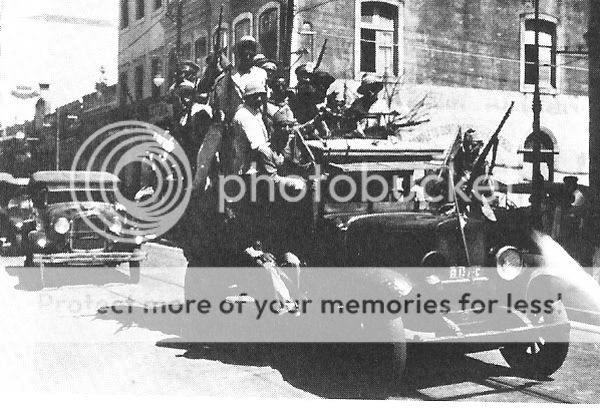
Uniformed Syndicate troopers on the advance
"We are pinned down! The Imperial Palace has been surrounded on all sides!"
-Imperial Police Captain Pierre Louis-Napoleon Bisset

Scenes from the Brazilian Revolution
At the beginning of the 1950s, the United Empire of Brazil and Rio de la Plata appeared to be a strong nation, ruled directly by Napoleon V. However, civil unrest was about to break out. Growing tensions between the French- and Spanish-speaking upper classes and the lower class Portuguese and natives were a major problem, and rampant worker abuse by private mining and lumber companies had triggered riots. Rio de la Plata, informally known as Argentina, was nominally loyal to the Emperor, and had a French and Spanish-speaking majority. In Brazil, however, the 19th Century writings of Hessian radical Meinrad Beutel were extremely popular among the lower classes. In 1953, rogue members of the Sindicato de Trabajadores de Brasil (Brazilian Workers Union) formed the Brazilian Beutelist Liberation Front (BBLF). Members of the BBLF began wearing olive drab uniforms, wearing surplus Republican Union pot helmets, and carrying weapons. When rumors circulated of worker abuse at factories, mines, and forests, BBLF guerrillas showed up to beat the living daylights out of the overseers and CEOs. In early 1954, the Sindicato Anarquista de Brasil(Anarchist Syndicate of Brazil) merged with the BBLF to form "The Syndicate." Using any means necessary, they vowed to topple the Imperial government and create a "free, safe, and libertine nation of the workers." On March 24th, 1954, a series of devastating car bombs went off all over Brazil and various government and corporate buildings. Over three hundred people were killed, and countless others injured. Over the next two months, non-stop terrorist attacks against the government and upper classes had every aristocrat living in fear.
On July 6th, 1954, over fifty thousand Syndicate members rallied to march on Rio de Janeiro, walking in on what they knew was a powder-keg situation. As the black and red flags filled the skies, violence quickly broke out. At around 4:35 PM, a regiment of police cavalry rushed the mobs of anarchists. Shouts of "Vive l'Empereur!" rang out against those of "Viva la revolucion!" and "Viva a revolução!" Shots rang out at around 5:02. By three hours later, the situation had grown completely out of control. Anarchists stormed a police armory and stole hundreds of weapons and armored vests. By 10:00 that night, firefights were breaking out all over the city. Bodies littered the grounds in front of the Imperial Palace as police snipers picked off rebels from on top of the roof. As the situation grew worse and worse, Napoleon V declared martial law and sent in the military. Landships rolled through the streets, smashing through ad-hoc Syndicate barricades
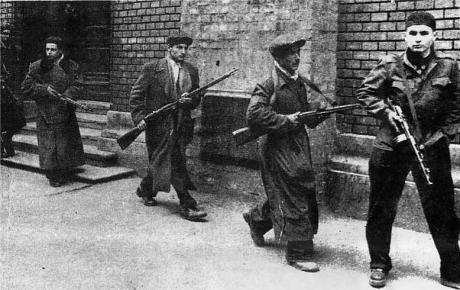
Syndicate members carrying stolen weapons leave the Imperial Police Armory in Rio de Janeiro On July 6th, 1954, over fifty thousand Syndicate members rallied to march on Rio de Janeiro, walking in on what they knew was a powder-keg situation. As the black and red flags filled the skies, violence quickly broke out. At around 4:35 PM, a regiment of police cavalry rushed the mobs of anarchists. Shouts of "Vive l'Empereur!" rang out against those of "Viva la revolucion!" and "Viva a revolução!" Shots rang out at around 5:02. By three hours later, the situation had grown completely out of control. Anarchists stormed a police armory and stole hundreds of weapons and armored vests. By 10:00 that night, firefights were breaking out all over the city. Bodies littered the grounds in front of the Imperial Palace as police snipers picked off rebels from on top of the roof. As the situation grew worse and worse, Napoleon V declared martial law and sent in the military. Landships rolled through the streets, smashing through ad-hoc Syndicate barricades


Imperial policemen take cover behind a squad car during Rio Uprising

Uniformed Syndicate troopers on the advance
Finally, upon the arrival of Imperial Marines at the port of Rio, the Syndicate revolutionaries were forced to retreat, fleeing north to Montes Claros. There, on July 23rd, 1954, they faced down thousands of Imperial soldiers in a bloody battle. Aeroships were going down left and right, covering the jungle in fire. By nightfall, the skies were alight with the flames of thousands of acres of burning trees. Under the jungle canopy, revolutionaries and Imperials fought hand-to-hand. By dawn, the Imperials were the ones on the retreat, leaving the Syndicate to lick its wounds and regroup.

Syndicate soldiers watch Imperial Paratroopers land during the Battle of Montes Claros
Over the next year and a half, the Syndicate tried to stay small, liberating individual villages and building up stockpiles of equipment and weapons. By late 1955, as the Empire-in-Europe was reeling from attacks from the Grand Alliance, the Syndicate saw it as the time to act. From December 12th, 1955, to February 15th, 1956, the Syndicate launched a massive attack against the government. On February 16th, Rio fell to their forces. The black-and-red flag of Beutelist Anarchy was raised over the Imperial Palace, which they promptly renamed the Brazilian House of the People. They proclaimed Brazil to be liberated of "foreign imperialism" and that it was now the "Brazilian Beutelist Republic."
In Argentina, the people rallied in the streets in favor of Caesar. Enlistment numbers sky-rocketed as thousands of young men rushed off to fight the "anarchist aggressor-traitors." A new frenzy of anti-Anarchist fearmongering swept the planet, especially in the Republican Union. Before, it had only tried to keep Gran Colombia busy while it dealt with the Southern nations. Now, Steele formed a concentrated effort to crush the Colombians so he could invade Brazil and topple the "Anarchist Latin Papist freedom-haters."
In April of 1956, thousands of American troops rushed the Colombian border defenses and crushed the Gran Colombian army. At an incredibly rapid pace, they leveled and destroyed one village and town after another. Their goal was not to occupy Colombia at the moment, but to steamroll through it, send it back to the stone age, and move on to Brazil.
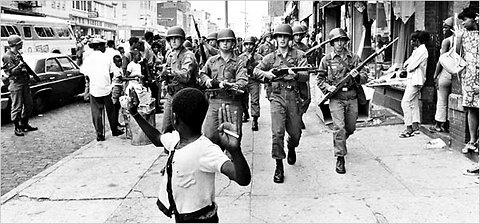
Union troops advance into a black ghetto in Bogota
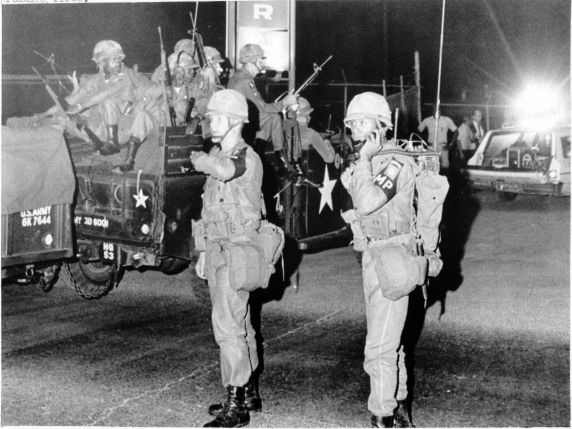
RUMP officers radio to headquarters during the Invasion of Gran Colombia

The bombed-out remains of Caracao, Gran Colombia
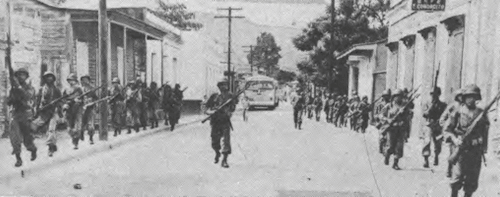
Union troops on the advance in Cartagena

Syndicate soldiers watch Imperial Paratroopers land during the Battle of Montes Claros
Over the next year and a half, the Syndicate tried to stay small, liberating individual villages and building up stockpiles of equipment and weapons. By late 1955, as the Empire-in-Europe was reeling from attacks from the Grand Alliance, the Syndicate saw it as the time to act. From December 12th, 1955, to February 15th, 1956, the Syndicate launched a massive attack against the government. On February 16th, Rio fell to their forces. The black-and-red flag of Beutelist Anarchy was raised over the Imperial Palace, which they promptly renamed the Brazilian House of the People. They proclaimed Brazil to be liberated of "foreign imperialism" and that it was now the "Brazilian Beutelist Republic."
In Argentina, the people rallied in the streets in favor of Caesar. Enlistment numbers sky-rocketed as thousands of young men rushed off to fight the "anarchist aggressor-traitors." A new frenzy of anti-Anarchist fearmongering swept the planet, especially in the Republican Union. Before, it had only tried to keep Gran Colombia busy while it dealt with the Southern nations. Now, Steele formed a concentrated effort to crush the Colombians so he could invade Brazil and topple the "Anarchist Latin Papist freedom-haters."
In April of 1956, thousands of American troops rushed the Colombian border defenses and crushed the Gran Colombian army. At an incredibly rapid pace, they leveled and destroyed one village and town after another. Their goal was not to occupy Colombia at the moment, but to steamroll through it, send it back to the stone age, and move on to Brazil.

Union troops advance into a black ghetto in Bogota

RUMP officers radio to headquarters during the Invasion of Gran Colombia

The bombed-out remains of Caracao, Gran Colombia

Union troops on the advance in Cartagena
As the war in South America drew troops away from the Southron Front in North America, a certain George Washington VIII was preparing to invade the Union and send Philadelphia reeling...
Last edited:
Now to comment on the last two of Napo's chapters.
As for the Camps one, wow, just wow. As if the RU couldn't get any more evil. Now I want to see the RU fall even more than before, but I fear they might win the war.
As if the RU couldn't get any more evil. Now I want to see the RU fall even more than before, but I fear they might win the war.  Still, I have hope for the League of Nations.
Still, I have hope for the League of Nations. 
As for the South America update, shits getting real. Kinda cool to see another far left uprising, just like the one in Wales. Considering how horrible the conditions seem to be in the work camps, I'm kinda rooting for the Beutelsit rebels to win this conflcit, so long Beutelist Brazil doesn't turn out like OTL's Stalinist USSR or Maoist China.
Considering how horrible the conditions seem to be in the work camps, I'm kinda rooting for the Beutelsit rebels to win this conflcit, so long Beutelist Brazil doesn't turn out like OTL's Stalinist USSR or Maoist China.
So, what are some symbols for Beutelist beside the Red and Black flag? Maybe two raised hands shaking each other while holding a hammer, with a gear around that?
As for the Camps one, wow, just wow.
As for the South America update, shits getting real. Kinda cool to see another far left uprising, just like the one in Wales.
So, what are some symbols for Beutelist beside the Red and Black flag? Maybe two raised hands shaking each other while holding a hammer, with a gear around that?
OMG I thought that Gran Colombia would do better after all jungle warfare is better when you are in the defensive, in my take the Union needed 3 months to crush Colombian
And WOW the Union is getting more crazy everyday
Frankly I hope the Union falls ... and I hope that Peru manage to give better resistance to the Union
And WOW the Union is getting more crazy everyday
Frankly I hope the Union falls ... and I hope that Peru manage to give better resistance to the Union
Thanks for the comments, guys!
@Zoid: Yeah, I should request some stuff in the flag thread for Beutelism.
@Warpath: You'll love the ending of this new chapter then.
@Doorcf: Well, they're not technically fighting a "war" in Gran Colombia. They're fine with letting rebels hide out in the jungles for now, just so they can get to Brazil to crush the "anarchist threat." To them, Gran Colombia is just a roadblock to more desirable conquests. Basically, in and out lightning war and onto Brazil.
I'm not even going to try to explain all the references contained in this chapter. It's so chock-full of obscure references and trivia it's insane. Pretty much every general's name is a thinly-veiled reference to an OTL Civil War general. For instance, Jurgen Ailes = George Meade. Get it? Ale/mead?
Pretty much every general's name is a thinly-veiled reference to an OTL Civil War general. For instance, Jurgen Ailes = George Meade. Get it? Ale/mead? 
-APOCALYPSE-@Zoid: Yeah, I should request some stuff in the flag thread for Beutelism.
@Warpath: You'll love the ending of this new chapter then.
@Doorcf: Well, they're not technically fighting a "war" in Gran Colombia. They're fine with letting rebels hide out in the jungles for now, just so they can get to Brazil to crush the "anarchist threat." To them, Gran Colombia is just a roadblock to more desirable conquests. Basically, in and out lightning war and onto Brazil.
I'm not even going to try to explain all the references contained in this chapter. It's so chock-full of obscure references and trivia it's insane.
WASHINGTON GOES NORTH

Carolinian troops prepare for battle near Gettysburg
Virginian General George Washington VIII was finally ready. Thanks to the Union having to divert men and materiel to South America to confront the "anarchist menace," they had softened their defenses along the Rockville Line. Now was the time to push on to Baltimore and invade the North, Washington said. He began making preparations for what appeared to be an invasion to retake the Delmarva Peninsula, but at the last moment revealed his true target had always been a thrust at Baltimore. The other Southron nations placed Washington in the position of Supreme Field Marshal of CEMA Forces. United, the Southron legions plowed northward in a devastating campaign which began on June 12th, 1956. Finally, following months upon months of stalemate, Baltimore (or what was left of it) was liberated from the Union army. A furious Chuckie Oswald found himself outmaneuvered and with nowhere to go but backward. He retreated across the border into Pennsylvania. There, Oswald expected his forces to be safe, but he was in for a nasty surprise when the CEMA forces chased him right in. On June 25th, 1956, Southron forces crossed over into Union territory. Planes and aeroships flew overhead, bombarding everything in sight. As Washington himself crossed the border, he began to realize the magnitude of the position he was in. He was only a little over 100 miles from Philadelphia itself. 38 miles from Harrisburg. 175 miles from the sacred Manifest Destiny Party rally grounds at Pittsburgh.
He picked Harrisburg. He had no confidence that he would be able to win a quick victory in or even near Philadelphia at all. Philadelphia would be defended to the last man if attacked, and reinforcements would eventually surround the CEMA besiegers. No, it had to be Harrisburg. Harrisburg was a major city and right in the heart of Yankeeland.
But first, there was the problem about a rumored second Union army coming south to stop him. Washington gave command of his corps to his crack, top-of-the-line generals, Virginian Jimmy Langstrasse, Georgian Rickie Sewell, and Carolinian P. A. Montagne. The elite landship corps was put under the command of Virginian Jebediah Stewart. Altogether, about 300,000 men and 300 landships were ready for action at the beginning of the month. By June 29, Washington's army was extended out in an arc from Chambersburg (28 miles northwest of Gettysburg) to Carlisle (30 miles north of Gettysburg) to near Harrisburg and Wrightsville on the Susquehanna River. Union General Jurgen Ailes was indeed coming down with over 200,000 men to reinforce Oswald's 150,000.
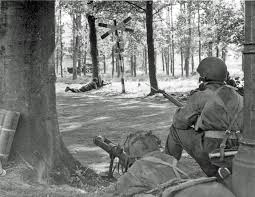
Members of the 13th ORRA Mechanized Unit during the initial skirmish at Gettysburg
On the 1st of July, 1956, Virginian troops first entered Gettysburg, looking for supplies for the march to Harrisburg. There, scouts for Oswald's main army, approximately 80 members of the 13th ORRA Mechanized Unit, ran into them by complete accident. A firefight ensued, which left 20 Virginian soldiers dead and an unknown number of the Bad Luck Brigade dead. Frantically, the surviving members of the 13th scurried back to Oswald to report the Southron presence.
As July 2nd dawned, Oswald hurried and laid out his forces along three ridges west of Gettysburg: Herr Ridge, McPherson's Ridge, and Seminary Ridge. His goal was to engage the Southrons just long enough so Ailes could occupy the strong defensive positions south of town at Cemetery Hill, Cemetery Ridge, and Culp's Hill. Oswald understood that if the Confederates could gain control of these heights, Ailes's forces would have difficulty dislodging them. Over the next several hours, the Southron forces achieved good victories, pushing Union troops back to McPherson's Ridge.
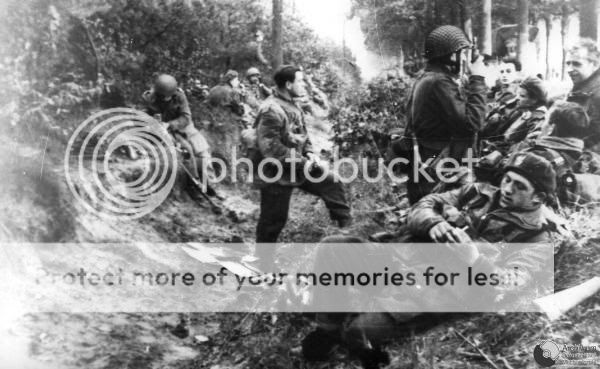
Union troops dig in at McPherson's Ridge
North of the Pike, the Bad Luck Brigade, gas masks equipped, were on the attack against Rickie Sewell's advance scouts and light landships. However, after an hour of intense firefights, a brigade of CoCaro heavy infantry managed to push the 13th back toward Seminary Ridge.

The battered Bad Luck Brigade withdraws back to Seminary Ridge
By now it was full-on chaos. Washington hadn't wanted to fight here, but at Harrisburg. Still he wanted to make the most of what he had. As the day came to a close, he was asked on the wireless phone by the Virginian House of Burgesses if Gettysburg was a proper site for a major battle. His response was, "I think this is the strongest position by nature upon which to fight a battle that I ever saw." As the day came to a close, over 50,000 men had been killed or wounded. The most severely damaged was the Union Army's Mechanized Battalion of Army Group I, Legion I, which suffered 50% casualties in just hours.
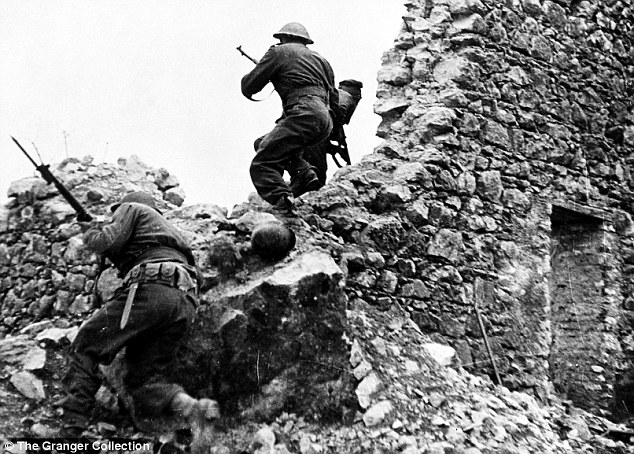
Georgian troops scurry over rubble near the Chambersburg Pike on the first day of the Battle of Gettysburg
He picked Harrisburg. He had no confidence that he would be able to win a quick victory in or even near Philadelphia at all. Philadelphia would be defended to the last man if attacked, and reinforcements would eventually surround the CEMA besiegers. No, it had to be Harrisburg. Harrisburg was a major city and right in the heart of Yankeeland.
But first, there was the problem about a rumored second Union army coming south to stop him. Washington gave command of his corps to his crack, top-of-the-line generals, Virginian Jimmy Langstrasse, Georgian Rickie Sewell, and Carolinian P. A. Montagne. The elite landship corps was put under the command of Virginian Jebediah Stewart. Altogether, about 300,000 men and 300 landships were ready for action at the beginning of the month. By June 29, Washington's army was extended out in an arc from Chambersburg (28 miles northwest of Gettysburg) to Carlisle (30 miles north of Gettysburg) to near Harrisburg and Wrightsville on the Susquehanna River. Union General Jurgen Ailes was indeed coming down with over 200,000 men to reinforce Oswald's 150,000.
Members of the 13th ORRA Mechanized Unit during the initial skirmish at Gettysburg
As July 2nd dawned, Oswald hurried and laid out his forces along three ridges west of Gettysburg: Herr Ridge, McPherson's Ridge, and Seminary Ridge. His goal was to engage the Southrons just long enough so Ailes could occupy the strong defensive positions south of town at Cemetery Hill, Cemetery Ridge, and Culp's Hill. Oswald understood that if the Confederates could gain control of these heights, Ailes's forces would have difficulty dislodging them. Over the next several hours, the Southron forces achieved good victories, pushing Union troops back to McPherson's Ridge.

Union troops dig in at McPherson's Ridge
North of the Pike, the Bad Luck Brigade, gas masks equipped, were on the attack against Rickie Sewell's advance scouts and light landships. However, after an hour of intense firefights, a brigade of CoCaro heavy infantry managed to push the 13th back toward Seminary Ridge.

The battered Bad Luck Brigade withdraws back to Seminary Ridge

Georgian troops scurry over rubble near the Chambersburg Pike on the first day of the Battle of Gettysburg
The Union line on the second day ran from Culp's Hill southeast of the town, northwest to Cemetery Hill just south of town, then south for nearly two miles (3 km) along Cemetery Ridge, terminating just north of Little Round Top. The shape of the Union line is popularly described as a "fishhook" formation. The CEMA line paralleled the Union line about a mile to the west on Seminary Ridge, ran east through the town, then curved southeast to a point opposite Culp's Hill. Thus, Oswald's army had interior lines, while the CEMA line was nearly five miles long.
Langstrasse slammed into Ailes's men at Devil's Den and Little Round Top. Mortars, light landships, belt-fed machine guns, and all the rest were mercilessly thrown at the enemy. Devil's Den saw hellishly intense fighting that ended in thousands dead, but with the Union still holding. Little Round Top was about to crack under CEMA pressure when the 20th Iowai Regiment of the Union Army, under Colonel Joshamee Camberton, formed a solid wall of bayonets and machine guns and sprinted down the hill. The Southrons had no choice but to back off at the sheer onslaught as bloody hand-to-hand fighting turned the forest floor red with blood.

Custer Youth Brigade Cadets fight to the death at Devil's Den
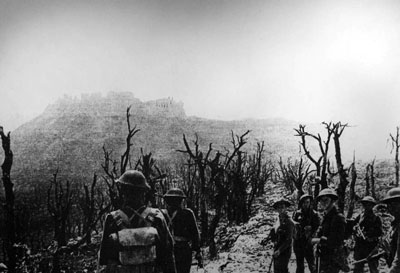
Georgian troops survey the surreal nightmare at Little Round Top

Famous photo of Virginian infantrymen storming up Devil's Den
Langstrasse slammed into Ailes's men at Devil's Den and Little Round Top. Mortars, light landships, belt-fed machine guns, and all the rest were mercilessly thrown at the enemy. Devil's Den saw hellishly intense fighting that ended in thousands dead, but with the Union still holding. Little Round Top was about to crack under CEMA pressure when the 20th Iowai Regiment of the Union Army, under Colonel Joshamee Camberton, formed a solid wall of bayonets and machine guns and sprinted down the hill. The Southrons had no choice but to back off at the sheer onslaught as bloody hand-to-hand fighting turned the forest floor red with blood.

Custer Youth Brigade Cadets fight to the death at Devil's Den

Georgian troops survey the surreal nightmare at Little Round Top

Famous photo of Virginian infantrymen storming up Devil's Den
July 3rd drew to a close with innumerable dead and an exhausted set of enemies. July 4th, the old Independence Day, was to prove the final day of the confrontation. The first half of the day was simply disorganized chaos as the opposing sides threw everything they had at each other and tried to hit each other with bombing runs and aeroships. One Virginian aeroship went down over Devil's Den and exploded in massive fireball, causing hundreds of casualties and setting the area on fire for hours. Faced with no other choice except burning to death, the Union troops fled the Den. Washington VIII immediately launched a new attack, desperately trying to put the fires out and claim the Den. Things were going CEMA's way. Oswald was furious at the "cowardly scramble," and sacked several of the officers involved on the spot. From that point till 4 in the afternoon, Washington claimed Devil's Den.
At 4, Jebediah Stewart was observed bringing up his heavy-class landships. Convinced he had only 30 minutes to achieve victory or face the landships, Oswald ordered General John Plunkett to lead his men in "a general assault." What it amounted to was a brutal suicide charge by 80,000 desperate infantrymen, some of them just teenaged members of the Custer Youth Brigade. At 4:05, the charge began over two miles of open terrain. Oswald had miscalculated. Instead of having twenty-some minutes left, Stewart was already in place at Devil's Den. The roar of a hundred landship guns echoed through the air as the exposed, unarmored Yankee infantry watched in horror as themselves and their comrades were blown to bloody bits in minutes. It was one of the costliest charges in military history. The surviving chargers who made it to the CEMA line without deserting or getting blown up were mowed down by machine gun nests and small arms fire. Some simply surrendered as soon as they arrived. General Plunkett, riding in a light armored vehicle, was killed by an exploding overhead mortar. His last words as he was dragged off the field were, "Damn Oswald! Damn that man to the depths of Hell for the young boys he has sent to their deaths today!"
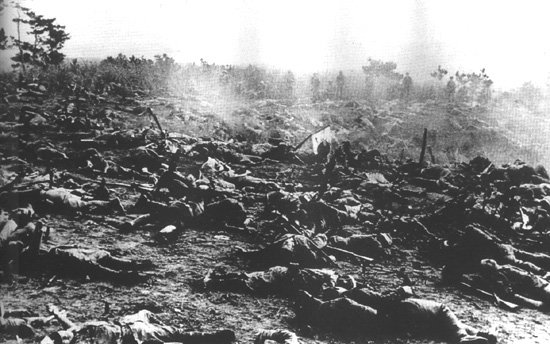
Oswald was defeated. Again. Rounding up the remainders of his army, he realized he had just lost 100,000 men (30,000 in Plunkett's Charge alone) in one of the bloodiest-per-day battles in human history. The air was not even breathable by nightfall, and both sides deployed gas masks to avoid the stench of the rotting piles of bodies. Washington had lost only 30,000. A catastrophic defeat, Oswald dashed back to Philadelphia as soon as possible for an emergency meeting with Steele, Nixon, and King.
In Oswald's absence, Jurgen Ailes became Supreme Commander in the field. He used brilliant strategy to get the surviving troops out of range of the South. Knowing that Harrisburg was the intended target, he marched north-east to the town York. There he requested immediate reinforcements from New York and New Jersey. New York came through with 80,000 fresh troops, but New Jersey was on the verge of total panic as rumors spread of Carolinian paratroopers landing in Delaware.

Carolinian paratroopers pose for a photo near Dover, Delaware
The rumors were true. Elite CoCaro paratroopers were indeed touching down in Delaware. But it was not an invasion, but rather another attempt by Washington to crush the Union's morale. With over 100,000 men slaughtered on their own soil, there was a rattling of the North's confidence in "Manifest Destiny." Washington claimed, "If we continue to be this successful, we will crush the Union by this time next year."
In reality, the Union was about to get a morale lift. Joe Steele was about to announce the development of a new "Wonder Weapon." It would end badly for the entire planet...
EDIT:
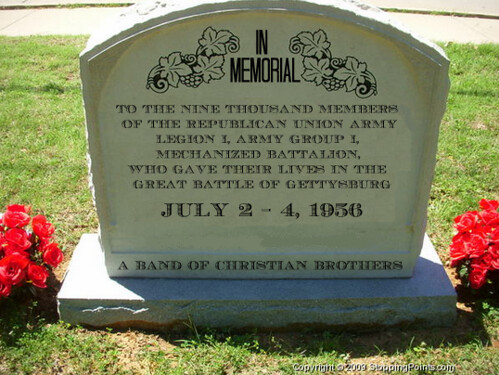

At 4, Jebediah Stewart was observed bringing up his heavy-class landships. Convinced he had only 30 minutes to achieve victory or face the landships, Oswald ordered General John Plunkett to lead his men in "a general assault." What it amounted to was a brutal suicide charge by 80,000 desperate infantrymen, some of them just teenaged members of the Custer Youth Brigade. At 4:05, the charge began over two miles of open terrain. Oswald had miscalculated. Instead of having twenty-some minutes left, Stewart was already in place at Devil's Den. The roar of a hundred landship guns echoed through the air as the exposed, unarmored Yankee infantry watched in horror as themselves and their comrades were blown to bloody bits in minutes. It was one of the costliest charges in military history. The surviving chargers who made it to the CEMA line without deserting or getting blown up were mowed down by machine gun nests and small arms fire. Some simply surrendered as soon as they arrived. General Plunkett, riding in a light armored vehicle, was killed by an exploding overhead mortar. His last words as he was dragged off the field were, "Damn Oswald! Damn that man to the depths of Hell for the young boys he has sent to their deaths today!"

The charred remains of the 19th New York Infantry near Devil's Den (Virginian soldiers can be seen in the background)
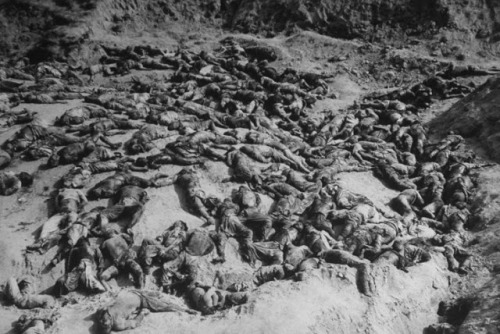

The countless bodies of Union dead following Plunkett's Charge
Washington VIII, observing the attack from a nearby hillside, told General Montagne, "It is well that war is so terrible, else we should grow too fond of it."
Oswald was defeated. Again. Rounding up the remainders of his army, he realized he had just lost 100,000 men (30,000 in Plunkett's Charge alone) in one of the bloodiest-per-day battles in human history. The air was not even breathable by nightfall, and both sides deployed gas masks to avoid the stench of the rotting piles of bodies. Washington had lost only 30,000. A catastrophic defeat, Oswald dashed back to Philadelphia as soon as possible for an emergency meeting with Steele, Nixon, and King.
In Oswald's absence, Jurgen Ailes became Supreme Commander in the field. He used brilliant strategy to get the surviving troops out of range of the South. Knowing that Harrisburg was the intended target, he marched north-east to the town York. There he requested immediate reinforcements from New York and New Jersey. New York came through with 80,000 fresh troops, but New Jersey was on the verge of total panic as rumors spread of Carolinian paratroopers landing in Delaware.

Carolinian paratroopers pose for a photo near Dover, Delaware
The rumors were true. Elite CoCaro paratroopers were indeed touching down in Delaware. But it was not an invasion, but rather another attempt by Washington to crush the Union's morale. With over 100,000 men slaughtered on their own soil, there was a rattling of the North's confidence in "Manifest Destiny." Washington claimed, "If we continue to be this successful, we will crush the Union by this time next year."
In reality, the Union was about to get a morale lift. Joe Steele was about to announce the development of a new "Wonder Weapon." It would end badly for the entire planet...
EDIT:

Last edited:
When I thought this story couldn't get any darker,Napoleon surprised me again.Compliments.
By the way,what did you think of my evil Santa ?
By the way,what did you think of my evil Santa ?
Zachanassian
Gone Fishin'
When I thought the Union couldn't possibly get any worse, it somehow manages to get worse...
Though the Middle East and to a lesser extent Russia both seem to be a rather bright spot of stability and hope amidst all this bleak madness.
Please please tell me that the RU doesn't have the Bomb. Let it be some sort of poisonous plane-based mine-bomb thing or giant death robot or chemical that strips your skin off or anything else beside the Bomb, just anything else besides the Bomb. Please?
Though the Middle East and to a lesser extent Russia both seem to be a rather bright spot of stability and hope amidst all this bleak madness.
Please please tell me that the RU doesn't have the Bomb. Let it be some sort of poisonous plane-based mine-bomb thing or giant death robot or chemical that strips your skin off or anything else beside the Bomb, just anything else besides the Bomb. Please?
Excellent Gettysburg update!  The references and trivia were really cool and fun to look for (I think I found most of them), and its nice to the Southron's win the battle.
The references and trivia were really cool and fun to look for (I think I found most of them), and its nice to the Southron's win the battle.  On a darker note, I hope the Union's "secret weapon" isn't the atomic bomb, but I have a feeling that it is.
On a darker note, I hope the Union's "secret weapon" isn't the atomic bomb, but I have a feeling that it is.  In that case, theres no way the Union can lose.
In that case, theres no way the Union can lose.
So if the Union does get the bomb, my prediction is that the Union and Grand Alliance win, annexing the Columbian nations, Quebec, French Canada, the Caribbean, Gran Columbia, the Guyanas, and maybe California and the Indian Territory. Then theres going to be a four way cold war between the RU, now the United States of America, Prussia, now the Greater Germanic Empire (having conquered the Rheinbund, the Netherlands, German land in France, Austria, Bohemia and Baden and was most Imperial African colonies), the Russian Republic and the Egyptian Empire, now the United Arab Empire. France and Spain will be balkanized, and so will Indonesia, now free from Dutch rule.
Just a prediction. Who knows, the LoN may still have a chance, and I'm certainly rooting for them to win.
So if the Union does get the bomb, my prediction is that the Union and Grand Alliance win, annexing the Columbian nations, Quebec, French Canada, the Caribbean, Gran Columbia, the Guyanas, and maybe California and the Indian Territory. Then theres going to be a four way cold war between the RU, now the United States of America, Prussia, now the Greater Germanic Empire (having conquered the Rheinbund, the Netherlands, German land in France, Austria, Bohemia and Baden and was most Imperial African colonies), the Russian Republic and the Egyptian Empire, now the United Arab Empire. France and Spain will be balkanized, and so will Indonesia, now free from Dutch rule.
Just a prediction. Who knows, the LoN may still have a chance, and I'm certainly rooting for them to win.
Excellent Gettysburg update!The references and trivia were really cool and fun to look for (I think I found most of them), and its nice to the Southron's win the battle.
On a darker note, I hope the Union's "secret weapon" isn't the atomic bomb, but I have a feeling that it is.
In that case, theres no way the Union can lose.
So if the Union does get the bomb, my prediction is that the Union and Grand Alliance win, annexing the Columbian nations, Quebec, French Canada, the Caribbean, Gran Columbia, the Guyanas, and maybe California and the Indian Territory. Then theres going to be a four way cold war between the RU, now the United States of America, Prussia, now the Greater Germanic Empire (having conquered the Rheinbund, the Netherlands, German land in France, Austria, Bohemia and Baden and was most Imperial African colonies), the Russian Republic and the Egyptian Empire, now the United Arab Empire. France and Spain will be balkanized, and so will Indonesia, now free from Dutch rule.
Just a prediction. Who knows, the LoN may still have a chance, and I'm certainly rooting for them to win.
You forgot that the Union would take over Peru, there is a ton of mineral and natural resources here
France owuld be divided by Prussia and England, they will not allow France to exist as an independent country
ALso you forgot Italy
Excellent Gettysburg update!The references and trivia were really cool and fun to look for (I think I found most of them), and its nice to the Southron's win the battle.
On a darker note, I hope the Union's "secret weapon" isn't the atomic bomb, but I have a feeling that it is.
In that case, theres no way the Union can lose.
The Union Wunderwaffe could be anything, it can be chemical, could be biological, could the the Bomb. All of 'em will fuck up the world badly, and who knows, maybe the League has its own Wunderwaffe.
Remember. In a dyspotia, everyone loses.
Napo whats going on in Dutch Indonesia and such, since the Dutch Empire has fallen and all? You said that parts of the Indonesia (possibly eastern) are being occupied by France, and that the rest is under control of various Dutch and Native warring warlords, but have any regions/peoples made any attempt at establishing an independent nation (Independent Malaya or Philippines or Indonesia for example)? I could see Vietnam and Cambodia declaring independence what with them experiencing violence in the past and them being so close to the Republic of China.
Deleted member 14881
So the Union isn't all that anti semitic sweet allohistrical irony a Jewish Menegele 
Share: